Edie Melson's Blog, page 96
March 9, 2023
Increase the Reach of Every Blog Post with 8 Things to Check AFTER You Hit Publish

by Edie Melson @EdieMelson
Recently I shared 15 Things to Check Before You Hit Publish . But publishing a post doesn’t mean our work is done.
There are even more things you can do then that make a big difference in how many people it reaches. This week I’m sharing how to continue that momentum with 9 things to do after you hit publish.
8 Things To Do After You Hit Publish
1. Check your inbox and make sure your post actually went out on time. I sign up for email updates for my blog as a safety net. That way, I know if a post doesn’t go out as scheduled.
2. Click on your site and give the post a final once-over proofread and format check. I don’t care how many times I proof a post, I almost always find something that needs tweaking after it’s gone live.
3. Schedule an update to go out on your social media networks. I try to schedule my updates later in the day because the email notification about my blog posts go out in the morning. By spacing out the announcements, I’ll reach more people.
4. Come back regularly during the day and answer comments. If you’ve ended the post with an open-ended question or call to action, it’s rude not to come back and join the conversation.
5. Keep an eye out for social media updates that tag your post. Thank and/or answer the people who mention your site. If you get a lot of mentions, consider answering them in a single list post like this:
Thanks for the mention @AneMullign @DiAnnMills @SharronCosby
Or just choosing one or two like this:
Thanks for the mention @CathySBaker @LoriRoeleveld and everyone who took time to drop by!
6. Check the people who share your post on social media and make sure you’re following them. If you have time and what they offer is appropriate, look for a way to share something of theirs.
7. Study the comments the post gets and look for any missing information you need to add. For instance, in 15 Things to do Before You Hit Publish, there were several comments asking for a printable list. I went back in add a link to the list (and I’ve done that for this post).
8. Mine your comments for possible future blog post topics. Again, when readers asked for a printable list, they also asked how I did that. Because of that, I’ll be posting a tutorial on how to host a document on Google Drive as an upcoming blog post.
These are things you can do to make sure your blog post reaches as far and wide as possible. What would you add to this list? Be sure to leave your suggestions in the comments section below.
Don’t forget to join the conversation!Blessings,Edie
TWEETABLEIncrease the Reach of Every Blog Post with 8 Things to Check AFTER You Hit Publish via @EdieMelson (Click to Tweet)
PDF Link: 8 Things to Check AFTER You Hit Publish
Don't Miss the Other Post in this Series: 15 Things to Do BEFORE You Hit Publish
Published on March 09, 2023 22:00
March 8, 2023
When One Writing Gig Leads to Another and Then Another

by Julie Lavender @JLavenderWrites
Edie Melson’s post last month, 8 Reasons Every Writer Should Stop Procrastinating and Write Something Right Now! asked readers to contribute by way of comments other reasons that she hadn’t included. At the time, nothing popped into my head. Several days later, when I signed a contract for an online-magazine article acceptance, I thought of something that might work for her list.
One Writing Gig Often Leads to Another and Then Another
As often happens with brand new writers, one of my first bylines appeared in a sweet publication entitled Welcome Home. The non-glossy, small-in-size print magazine had just a few sketches that served as illustrations throughout the publication and focused on stories for stay-at-home moms.
I was a new SAHM, with six years of teaching under my belt and a newborn in his crib. One article led to another, and those credits on my resume helped me get my first paying gig in Lifeway’s ParentLife Magazine with an article called “Mud Puddles and Lesson Plans.” After two articles appeared in ParentLife with my byline, an editor reached out with an opportunity to contribute regularly to their “ages and stages” columns at the front of each magazine.
With that published ParentLife article focusing on homeschooling on my resume, I reached out to Homeschooling Today Magazine with a unit study idea written in the format of those included in each issue of their print magazine. That one acceptance led to assignments from the editor for several years.
Filling out an extensive application for Group Publishing, Incorporated that included a sample curriculum lesson—that resulted in an acceptance to join their freelance pool of writers—gave me assignments for the next several years. In fact, I once counted up my contributions and I’d written approximately 145 curriculum lessons in 21 Group teacher resource books!
And, several years after my writing gigs with Group had diminished, a fellow Group writer whom I’d met at an in-person Group writing retreat, asked me to come alongside her and write children’s news articles for the Denver Post. Boy, did we have fun with those articles!
Because an acquaintance at a local bank knew about my curriculum writing, she reached out to me when the bank chose to do a promotional booklet for customers and asked if I’d pen an activities calendar for fun things to do with kids.
After writing a family column for my newspaper, the Statesboro Herald for a number of years, the editor called to ask if I’d consider writing faith-based articles for the paper, but he mentioned that he’d only want one every four or six weeks. I happily accepted the assignment. I’d only written two or three articles when I received an email from him that said, “Send me these kinds of articles as often as you want.” With all the seemingly “bad” news that often shows up in newspapers, our community welcomed inspirational articles to read!
A couple of those early newspaper stories caught the eye of the editor of Statesboro Magazine, our hometown print magazine, and I enjoyed several assignments that involved interviewing locals and reporting on local happenings.
When my second book released, a homeschooling devotional, an editor from the religious division of Carson-Dellosa reached out and asked if I’d consider writing a teacher resource book that editors titled Scripture Adventures. I happily accepted and later received requests for two more books, Super Men of the Bible and Wonder Women of the Bible.
A Guideposts Magazine writing contest win in 2014 with eleven awesome writers, gave me the opportunity to eventually publish in all four of their major publications and on their website. Later, I was invited by Guideposts editors to submit pieces to a devotional magazine, two devotion compilations, and their Christmas special edition.
Several years after winning the contest, a Guideposts editor with whom I’d worked passed along an email callout to me and other children’s writers he knew. With another extensive application process, a sample writing piece, and several weeks of waiting, I found out I was selected to take part in a writing project assignment that became my most recent publication, Children’s Bible Stories for Bedtime, published by a Penguin Random House imprint.
During three decades of writing, I’ve watched one writing gig lead to another and then another and then another. As a God-loving, Bible-believing, Jesus-praising author, I know my Heavenly Father orchestrated the path of each of these writing credits. But it’s certainly been fun to watch how He used each project to lead me on the journey to the next one.
As Edie says, “Don’t procrastinate.” And, as Julie adds, “Don’t put off writing today what might turn into another writing gig tomorrow.”
TWEETABLEWhen One Writing gig Leads to Another and Then Another, insight from @JLavenderWrites on @EdieMelson (Click to Tweet)
 Julie is the author of Children’s Bible Stories for Bedtime, published by Zeitgeist/Penguin Random House, and 365 Ways to Love You Child: Turning Little Moments into Lasting Memories, published by Revell/Baker. She’s also written more than 1000 newspaper and magazine articles and enjoys encouraging fellow writers to get their foot in the door of the publishing industry with shorter pieces. Connect with Julie at julielavenderwrites.com and on social media platforms.
Julie is the author of Children’s Bible Stories for Bedtime, published by Zeitgeist/Penguin Random House, and 365 Ways to Love You Child: Turning Little Moments into Lasting Memories, published by Revell/Baker. She’s also written more than 1000 newspaper and magazine articles and enjoys encouraging fellow writers to get their foot in the door of the publishing industry with shorter pieces. Connect with Julie at julielavenderwrites.com and on social media platforms.
Published on March 08, 2023 22:00
March 7, 2023
When You Get a Writing Sabbatical You Didn't Ask For

by Linda Gilden @LindaGilden
Many writers would scoff at the idea of a writing sabbatical. As soon as a viable and exciting idea comes into their heads, they are ready to take off and get the article or book finished while they are passionate about it. Your sabbatical, however, may not come through your choosing.
When are the times that you are forced to pull back and possibly even abandon your writing all together for a season?
1. Times of grief or family crisis. Many times you wonder what you would do if you had a crisis in your family or even experience the difficult time of losing a loved one. Before experiencing a crisis, you may think there is nothing in this world that would prevent you from taking the next step in your career. But as soon as something happens, you may wonder how you will ever want to write again.
So what do you do? Do you resign yourself to resting a few days then resume your writing? Do you go out with friends and try to forget the difficult path you are on? Or do you resign yourself to the fact that God has allowed this in your life at this time and you do your best to rest in Him?
2. A time of personal health crisis where you are not even able to sit up much less write. Or maybe it’s your spouse that is suffering in poor health and you become the caregiver. In either case, it’s reasonable to consider letting something go. Many times we just can’t handle everything on our plates and know that we need to cut something out, at least for a season. So do you struggle to keep all your projects going even if it means late nights and early mornings? Do you mope around the house thinking, “Why me? I just feel like I am getting a grip on my writing career.” Or do you once again recognize the hand of God in your life and feel His presence and peace?
3. A time of major life change. Your spouse has retired and you have made plans to move your entire family to the next county. Your spouse has promised to do most of the packing and moving while you continue writing. However, there are just certain things that only you can do or go through. So once again your writing takes a back seat to the other chores that must be done. You may be able to drop the writing pace a little but that actually feels more like you have given up your dream. Do you cry yourself to sleep and wish that your dream could continue just like other writers you know? Do you resolve yourself to fulfilling the retirement dream you have talked about for years? Or do you consider this just a bump in the road and trust that God is going to help you fulfill your dream at some time in the future?
God cares about your writing career. If He has called you to write, He is not going to let you just drop the mission He has called you to. There may be a few bumps or potholes in the road along the way. But He will carry you through them and bring you out on the other side, ready to resume your calling of writing to change the world.
Use your time to read good books in the genre you write. Enjoy the books as you study those written by masters in your genre.
You can trust God with your problems, your career, and your life. Keep talking to Him and building your trust. Read His Word every day and journal those verses that speak to you. Don’t let the enemy discourage you from following your dream but cling to God’s plan as you walk, especially through difficult times.
When He thrusts you into a writing sabbatical, thank Him for all He has done thus far with your writing and let Him know you trust Him and are ready to write again as soon as He gives you notice. Be faithful and spend your time drawing closer to Him so when you get back to your computer you will have lots of new things to say that will encourage others.
TWEETABLEWhen You Get a Writing Sabbatical You Didn't Ask For, insight from @LindaGilden on @EdieMelson (Click to Tweet)
 Linda Gilden has coauthored 11 books with 5 different coauthors and has #12 and #13 coming out in 2022, adding a new co-author to the list. She loves every one of her coauthors and enjoys collaborating on interesting projects with them. She also has written many books on her own and realizes what a treasure and blessing a good co-author is.
Linda Gilden has coauthored 11 books with 5 different coauthors and has #12 and #13 coming out in 2022, adding a new co-author to the list. She loves every one of her coauthors and enjoys collaborating on interesting projects with them. She also has written many books on her own and realizes what a treasure and blessing a good co-author is.
Published on March 07, 2023 22:00
March 6, 2023
Enhance the Setting of the Story You're Writing
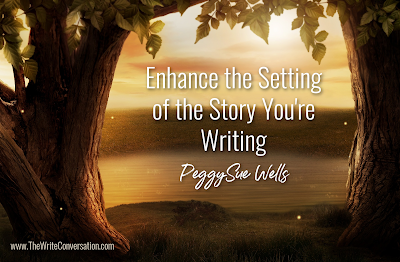
by PeggySue Wells @PeggySueWells
Setting is where your story takes place. Settings come in four types: passive, active, functions like a character, and when setting is the story.
Setting isTime PlaceSurroundingsMoodCultural nuancesHistorical periodA backdrop for a story
Placing your story in San Francisco? I Remember Mama’s sweet family connections and Old Country traditions is a completely different setting than the City by the Bay experienced by Sam Spade in Dashiell Hammett’s Maltese Falcon. San Francisco for Mama and her family is a place of honest work, a male cat named Elizabeth, visiting authors, and seeing her children come of age. San Francisco is much darker for the gumshoe who lurks in shady hotel rooms, betrayed by a mysterious woman, and given a package by a dying sea captain while he seeks to solve the murder of his partner.
Wherever a story is placed, a writer sets the tone and mood by what is included and what is left out of the setting. Images of a high-performance race track, the serene canals in Venice, a country inn in Vermont, a castle in England, a kibbutz in Israel’s desert, and a French child kissing the cheek of a World War II soldier each present a unique background, time frame, mood, and cultural nuances.
Setting is a playground for foreshadowing. Sunny weather reflects peace, resolution, promise, and hope. Inclement forecasts predict bad news, heartbreak, challenges, and difficulties. In Chasing Sunrise, as Hurricane Hugo bears down on the island, the antagonist becomes a stronger threat, and the stakes rise for our hero, Michael Northington, and those he cares about. “The leaves fell early that year,” described Hemingway in A Farewell to Arms. Dorothy sings Somewhere Over the Rainbow just before the tornado whisks her away in The Wizard of Oz
A setting where common actions that go awry, wardrobes malfunction, and routines are interrupted alert readers that something is brewing.The parachute doesn’t open during a HALO jump in Chasing Sunrise.While in the shower, the wife of an astronaut nearly loses her wedding ring down the drain in Apollo 13.In The Patent, as the FBI makes a plan to stop America’s enemies from stealing the nation’s best designs, the boss misses his target when he tosses his coffee cup onto the trash.
Incorporated into setting, color symbolism effectively adds layers of mood and nuance. Blue and orange are neutral in their symbolismBlack indicates deathRed points to violence and pending bloodshedGreen is for new lifeWhite shows lifeGold represents wealth Purple signifies royaltyPink is indicative of femininityYellow means bright, summer, hopeBrown symbolizes earthiness (Think Farmer Brown)
The Lone Ranger is dressed in white and rides a white charger, assuring viewers he is the good guy. At the Royal English Court, everyone is in pastel colors except Paul Chauvelin who is entirely in black in the made-for-TV Scarlet Pimpernel.
What do the colors of the dresses of Disney princesses say about them?
Use setting to touch the emotions of your reader. Take your character through a cemetery, near a ravine, by rushing water, across a busy highway. Give a view of a peaceful beach, a baby nursery, or the cheering crowd at the end of an athletic event.Have things in your setting malfunction from a non-working phone to the sudden flat tire, the delayed commuter train, and the grid that loses power.Insert into your setting a cat that steaks across the path, a legend, an eclipse, a glimpse the character talks themselves out of thinking they saw.
Weather, odors, music, art, food, customs, routines, holiday traditions, and animals are all aspects you can craft into your setting to bring a sense of time, place, and mood. When struggling to make your writing work, change the setting so the story could not happen anywhere else.
TWEETABLEEnhance the Setting of the Story You're Writing, insight and tips from author @PeggySueWells on @EdieMelson (Click to Tweet)
 Tropical island votary and history buff, PeggySue Wells parasails, skydives, snorkels, scuba dives, and has taken (but not passed) pilot training. Writing from the 100-Acre Wood in Indiana, Wells is the bestselling author of thirty books including The Slave Across the Street, Slavery in the Land of the Free, Bonding With Your Child Through Boundaries, Homeless for the Holidays, Chasing Sunrise, and The Ten Best Decisions A Single Mom Can Make. Founder of SingleMomCircle.com, PeggySue is named for the Buddy Holly song with the great drumbeat. At school author visits, she teaches students the secrets to writing and speaks at events and conferences. Connect with her at www.PeggySueWells.com, on Facebook at PeggySue Wells, and LinkedIn at linkedin.com/in/peggysuewells
Tropical island votary and history buff, PeggySue Wells parasails, skydives, snorkels, scuba dives, and has taken (but not passed) pilot training. Writing from the 100-Acre Wood in Indiana, Wells is the bestselling author of thirty books including The Slave Across the Street, Slavery in the Land of the Free, Bonding With Your Child Through Boundaries, Homeless for the Holidays, Chasing Sunrise, and The Ten Best Decisions A Single Mom Can Make. Founder of SingleMomCircle.com, PeggySue is named for the Buddy Holly song with the great drumbeat. At school author visits, she teaches students the secrets to writing and speaks at events and conferences. Connect with her at www.PeggySueWells.com, on Facebook at PeggySue Wells, and LinkedIn at linkedin.com/in/peggysuewells
Published on March 06, 2023 22:00
5 Things to Focus on When Defining True Writing Success

by Edie Melson @EdieMelson
For where your treasure is, there your heart will be also. Matthew 6:21
One thing I’ve noticed is that we writers are way too hard on ourselves. We’re constantly comparing ourselves to each other, looking for affirmation through someone else’s opinion about our work and even our calling.
We check to see how many views our articles get, how many followers our blogs have and how many stars the reviewer gave our latest book. These things can undermine and sometimes even totally destroy our perspective, not to mention our confidence. Because, let’s face it, there is always someone willing to point out what we did wrong or could have done better.
If we’re not careful, we can get to the point where we treasure what others are saying about us more than what God is doing through us.
So how do we stay focused in this crazy writing world where everyone seems eager to pass judgment? I think the key to thriving is to keep focused on what and especially on WHO truly matters.
These are somethings I focus on when life seems out of focus. Because when life goes out of focus, it’s almost always a priority issue.
These are the things I look at to make sure my priorities are in line.
1. My prayer focus. Even though I know I need to always begin writing with a time of prayer, that seems to be the first thing I forget when I get stressed. Having a daily quiet/prayer time is part of my life routine, but that’s not enough. I must begin every writing time with prayer.
2. Time in God’s word. If my daily time with God begins to shrink or disappear, then my writing life suffers.
3. Remembering the why. Yes, I’ve always been a writer, but when I answered God’s call to write for Him, my foundation changed. When I find myself chasing numbers, I go back to number 1. I refocus on my calling and more importantly the one who called me.
4. I refocus on relationships, instead of connections. There is a difference in these two. Relationships are built, connections are just numbers. Connections—when nurtured—often grow into relationships, but only when we concentrate on serving people instead of amassing numbers.
5. I rehearse what God has already done. No matter where you are on your writing journey, you have already seen God at work. Make note of the good things along the way—the whispers from God you’ve heard in your soul, the honest words of encouragement others have spoken or written to you, the successes you’ve had. We place far too much focus on the things we’ve done wrong, instead of the amazing things God is doing through us.
Bottom LineI’ve found that when I treasure God’s word and His opinion, my heart stays safe and protected. I’m insulated from a worldly perspective determined to destroy anything God has called good.
TWEETABLE5 Things to Focus on When Defining True Writing Success from @EdieMelson (Click to Tweet)
 Edie Melson is a woman of faith with ink-stained fingers observing life through her camera lens. She’s a writer who feels lost without that device & an unexpected speaker who loves to encourage an audience. She also embraces the ultimate contradiction of being an organized creative. She knows the necessity of Soul Care and leads retreats, conferences & workshops around the world on staying connected to God. Her numerous books, including the award-winning Soul Careseries & reflect her passion to help others develop the strength of their God-given gifts. Her blog, The Write Conversation is recognized as one of the top 101 industry resources.
Edie Melson is a woman of faith with ink-stained fingers observing life through her camera lens. She’s a writer who feels lost without that device & an unexpected speaker who loves to encourage an audience. She also embraces the ultimate contradiction of being an organized creative. She knows the necessity of Soul Care and leads retreats, conferences & workshops around the world on staying connected to God. Her numerous books, including the award-winning Soul Careseries & reflect her passion to help others develop the strength of their God-given gifts. Her blog, The Write Conversation is recognized as one of the top 101 industry resources. She and husband Kirk have been married 40+ years and raised three sons. They live in the foothills of the Blue Ridge Mountains and can often be found hiking—with Edie clinging to the edge of a precipice for the perfect camera angle and Kirk patiently carrying her camera bag and tripod. Connect with her on her website, www.EdieMelson.com and through social media.
Published on March 06, 2023 17:40
March 5, 2023
How to Write in Busy Life Seasons
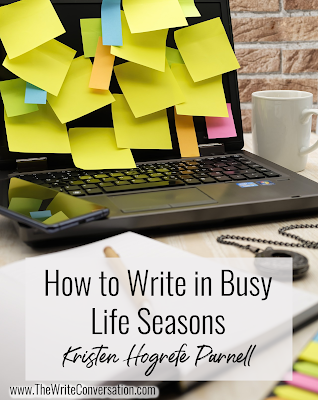
by Kristen Hogrefe Parnell @KHogrefeParnell
How do you write in busy life seasons? This is a question I’ve asked myself. My baby boy will be seven months old when you read this post, and being his mama is one of my life’s biggest joys. Finding time to write in this season is one of my biggest challenges.
Have I arrived at the answer? No. However, I’ve learned a few lessons during the past months that I hope may encourage other writers who find themselves in busy seasons as well.
Tips to Keep Writing When Life Gets Busy
#1: Accept that you can’t do it all.
Repeat out loud: I cannot do it all.
Feel better? Maybe. Maybe not.
Regardless, accepting our own limitations can be freeing. It is also a reminder that we can’t do anything in our own strength and that we must lean hard into Jesus’ strength (Philippians 4:13).
I also think back to the story of Mary and Martha, two very different sisters. Luke 10:38-42 describes Martha as so consumed with serving Jesus, that she missed out on what mattered more: simply being present with Jesus, as her sister Mary was.
If I were to try to achieve my pre-baby writing output, I would quickly become frazzled and ineffective. I would also miss out on the gift of this precious time with my baby and husband.
Not only should we accept that we can’t put out the same writing work when other responsibilities take precedence, but we should also embrace the season where God has blessed us with other priorities. Our word counts might be smaller, but perhaps they will be richer.
#2: Prioritize what you can do.
A few evenings each week, after my sweet son falls asleep, I slide into bed and give myself about thirty minutes with my laptop. Perhaps I work on an article I’ve promised someone, review chapter recordings for the audio book of my latest release, or respond to a message from a friend.
There are so many things I could do, but only so many that I can. To decide how to spend this time, I ask these questions:Is it urgent? (Example: deadlines, interview recording dates, etc.)Is it important? (Example: writing I’ve committed to do but isn’t due yet)
Some writing is important but not urgent. Some is both urgent and important. I try to do those tasks first, then my important ones, and save the less important for later. Along the way, I also have to say “no” to some good opportunities that time simply won’t allow.
#3: Recognize that your writing may look different in this season.
I’m so thankful I finished the second book in my two-book contract before my baby arrived. As he gets older (and sleeping through the night hopefully becomes part of the norm), I anticipate having more energy and a little more time in the evening to commit to larger writing projects.
For now, though, writing looks like a few articles, a book review, or maybe a blog post. I won’t be penning any great American novel during his first year of life.
And that’s okay. In fact, it’s more than okay. My baby is an answer to prayer and one of the greatest blessings in my life. Being his mama means that right now, I don’t have much free time to write, because I’m spending it with him. Caring for him. Loving him. Watching him discover the world one miraculous day at a time.
What is keeping you busy right now and perhaps not allowing as much time for your writing? Instead of lamenting the time you don’t have, recognize this reason as a source of blessing. Focus on the joy, and remember that eventually, the writing will return.
TWEETABLEHow to Write in Busy Life Seasons, 3 Tips from author @KHogrefeParnell on @EdieMelson (Click to Tweet)
 Kristen Hogrefe Parnell writes suspenseful fiction from a faith perspective for women and young adults. Her own suspense story involved waiting on God into her thirties to meet her husband, and she desires to keep embracing God’s plan for her life when it’s not what she expects. Kristen’s books have won the Selah Award and the Grace Award, among others, and her romantic suspense novel Take My Hand is now available. An educator at heart, she also teaches English online and enjoys being a podcast guest. Kristen lives in the Tampa, Florida area with her husband and baby boy. Visit her online at KristenHogrefeParnell.com.
Kristen Hogrefe Parnell writes suspenseful fiction from a faith perspective for women and young adults. Her own suspense story involved waiting on God into her thirties to meet her husband, and she desires to keep embracing God’s plan for her life when it’s not what she expects. Kristen’s books have won the Selah Award and the Grace Award, among others, and her romantic suspense novel Take My Hand is now available. An educator at heart, she also teaches English online and enjoys being a podcast guest. Kristen lives in the Tampa, Florida area with her husband and baby boy. Visit her online at KristenHogrefeParnell.com.
Published on March 05, 2023 22:00
March 4, 2023
Increase the Reach of Every Blog Post with 15 Things to Check BEFORE You Hit Publish

by Edie Melson @EdieMelson
We all want every blog post we publish to be the best it can be. Beyond that, we want our posts to get found. For that to happen, we have to increase the reach of every blog post we write.
It's hard to remember all the things that go into an effective post, so I've compiled a checklist for my own blogging and today I'm going to share it with you.
15 Things to Do Before You Hit Publish
1. Determine the main keyword phrase for your post. Do this by finding the focus of the post and For this post, the keyword phrase is Increase the Reach of Every Blog Post.
2. Compose a title for your blog that contains this keyword phrase. It will help get your blog found if that title is phrased like something that would be typed into a search engine.
3. Add labels/tags to your post. These should always include: keywords, the title of the blog post, the name of the author (even if you’re the only author who ever writes for your site), the title of your blog site, if it’s different than your name (the title of my blog site is The Write Conversation, so that’s one of my labels). Here's a blog post with the specifics of How to Apply SEO to Your Blog
4. Make sure there is a byline at the top of the post. In WordPress, that can be set up to show automatically. In Blogger, you’ll need to treat that as part of your blog post. With that byline, include a link to your Twitter account for easy sharing on social media.
5. Read your post out loud. This will help catch any typos or awkward sentences you may have missed before.
6. Compose an open-ended question or call to action for the end of your post. This will help engage your audience. And Don’t forget to come back and answer the comments.
7. Look at word count. An ideal length for most posts is 700-800 words. There are exceptions and if your blog is an exception, notice what word-length works best for you.
8. Check for formatting. Look for clear and concise (and mainly short) sentences. Check to make sure your paragraphs no longer than 50 words. Search for extra spaces or extra blank lines. They are more apparent online than in print.
9. If the blog post is written by a guest, include a bio and headshot. This bio should include social media links—so readers can connect—as well as an book links.
10. Verify all hyperlinks are working. There is nothing more frustrating than to click on a dead link. Google actually penalizes sites by reduced SEO if they have dead links. So take time to double-check.
11. Make sure your images are captioned. Images aren’t easily searchable online, but images that are captioned are. This adds extra power to the SEO of your blog post.
12. Check the position of your images. Pictures and graphics should illustrate your post, not interrupt the flow of the text. Think of it like a magazine layout.
13. Add a Click to Tweet or Tweetdis for easy sharing. Tweetdis is a paid plugin for Wordpress and won’t work on Blogger, but it’s becoming my new favorite for my WordPress sites. Click to Tweet is free.
14. Preview your post. Take an extra minute and preview your post one last time. Especially if you've made changes, this help ensure they haven't caused other issues.
15. Schedule your post. I know this sounds like a no-brainer, but occasionally I forget to hit schedule and the post ends up as a draft and is late when I discover my mistake.
By consistently checking for each of the 15 things listed above, you’ll increase the reach of your individual posts and the overall reach of your blog. I’d love to know what you’d add to the list. Be sure to leave your suggestions in the comments section below.
(NOTE: if you want to print this list, there's a link at the end to allow that)
Don’t forget to join the conversation!Blessings,Edie
TWEETABLEIncrease the Reach of Every Blog Post with 15 Things to Check BEFORE You Hit Publish via @EdieMelson (Click to Tweet)
PDF LINK: 15 Things to Check BEFORE You Publish Your Blog Post
Published on March 04, 2023 22:00
March 3, 2023
The Writer's Curiosity and the Key to Keeping Your Imagination Open

by Tim Suddeth @TimSuddeth
I started a new short story today. Isn’t that great?
Well, actually it isn’t. (Although I’m sure the story will be. Isn’t that the great thing about starting something new?) I’m already suffering from a strong case of paralysis by analysis. That’s when you have so many choices, you don’t know where to start. When your imagination goes into hyper-drive. I need (Notice that word I used there. That is part of the problem, isn’t it?) to work on my blog, finish a short story for a mystery magazine, finish my work-in-progress (which is the third in a series, so I can’t just drop it.), and send out more query letters so I can get notes from such nice people saying, “Your story just doesn’t quite work for me.”
So, of course, my brain goes, “Let’s start a new story.”
That’s one of the juggling acts all writers face. We sometimes call them distractions. Ideas that just pop into our heads, even when it’s inconvenient.
Yet, one of the greatest superpowers that writers have is our imagination. You’re in the shower, in line at Walmart, or just out walking and your brain buzzes with all sorts of ideas. Your imagination is acting like a manufacturing line. Then you get home and turn on your computer and, chirp, chirp. Crickets.
I can see you now. Smiling and going, “That’s me, Tim. You’re right. What can I do about it?”
Beats me. It drives me crazy, too.
Okay. Common wisdom is to just soldier through to the end. One word, one sentence, one page at a time. And that’s good advice, so I’ll go with that.
But that isn’t the part of writing I’m talking about. I’m talking about the times when you catch an idea, or vice versa, and it carries you on a journey that you didn’t expect. And when you finish, you hurry to print it out, then go to ambush the nearest victim to share the miracle you just experienced.
Who knew I was such a genius?
That’s the writing we become addicted to, isn’t it? The serendipity of writing. You think you know what you’re writing, but something even better emerges. It doesn’t always show up when we want. And sometimes it leaves too soon. But when you’re clutching the reins, it carries you on quite a ride.
Yes, writing is work. It’s hard work. But sometimes, sometimes, the souffle comes out just right. You come up with just the right analogy or plot twist. The words fall into place, revealing a thought that amazes you.
So, how do I make it happen?
The key thing is to keep putting yourself out there. Allow yourself to pursue the ideas that pop into your head.
Open the blank page. Put up the sail. Open yourself to the possibilities. Sometimes you’ll get just a puff and it won’t take you far enough. Frustrating, but okay. These quick trips will strengthen your muscles for when the breeze is stronger.
And when a stout breeze comes, hold on. Let it zip you over the water. Watch the characters, the setting, the plot develop. See how the theme and message seemingly magically emerge from the water.
That’s why we should always be open to new ideas. Even those that try to shove others out of the way. Try to sneak through a window while you are sound asleep.
Stay curious about new ideas. Keep the sail handy. Because you never know when an idea will sweep you away on an exhilarating ride.
TWEETABLEThe Writer's Curiosity and the Key to Keeping Your Imagination Open from @TimSuddeth on @EdieMelson (Click to Tweet)
 Tim Suddeth is a stay-at-home dad and butler for his wonderful, adult son with autism. He has written numerous blogs posts, short stories, and three novels waiting for publication. He is a frequent attendee at writers conferences, including the Blue Ridge Mountain Christian Writers Conference and a member of Word Weavers and ACFW. He lives near Greenville, SC where he shares a house with a bossy Shorky and three too-curious Persians. You can find him on Facebook and Twitter, as well as at www.timingreenville.com and www.openingamystery.com.
Tim Suddeth is a stay-at-home dad and butler for his wonderful, adult son with autism. He has written numerous blogs posts, short stories, and three novels waiting for publication. He is a frequent attendee at writers conferences, including the Blue Ridge Mountain Christian Writers Conference and a member of Word Weavers and ACFW. He lives near Greenville, SC where he shares a house with a bossy Shorky and three too-curious Persians. You can find him on Facebook and Twitter, as well as at www.timingreenville.com and www.openingamystery.com.
Published on March 03, 2023 22:00
March 2, 2023
Worldbuilding 101 For Writers: Writing People Groups and Social Circles

by A.C. Williams @ACW_Author
If the main character of the story you’re reading right now is a member of the military, how do you expect them to act? What if it’s a military where the air force rides dragons?
If the main character is a person from an aristocratic family, who are members of their approved social circle? What would happen if one of them ran away to join the circus?
If the main character is a person from a servant culture on a planet where cities can only survive underground, how would they express the longing for freedom?
No matter what kind of story you’re writing, if the heart of the story isn’t about people, the story isn’t going to make a difference to your readers. People are one of the foundational basics of worldbuilding, regardless whether you’re writing speculative fiction or not.
Last month, in our Worldbuilding 101 series, we talked about Existing History and how vital it is that your storyworld have an origin that most people living in the world are at least somewhat familiar with. This month, we’re going to talk about the people who live in that world.
One of the greatest mistakes I see writers make is not allowing the fantastic worlds they build to have an affect on their characters (and vice versa). When you design a character to experience the story you’re building, if that character isn’t a product of his or her environment, your readers will sense a disconnect.
If your character has grown up in a high society sort of culture, he or she will be accustomed to being served, to wearing fine clothing, and to having access to all the luxuries your world has to offer.
On the opposite side, if your character has grown up in a servant culture, he or she will know how to fight (usually figuratively but sometimes literally) for survival. They’ll be resilient. They’ll be strong. They won’t expect anyone to do for them what they can do for themselves.
We’ll talk in greater detail later on about how different types of environments will influence your characters, but today where I’d like to focus in on class and culture.
As much as we hate to admit it, the natural tendency of most people is to label each other. Our default is to mingle with people of similar backgrounds or similar appearances. It’s a unique person who seeks out the ones who are different.
Your characters may not (or maybe they do) have feathers, but I guarantee they will totally flock together with others just like them. There is safety and acceptance among the like-minded. That’s true in reality, and it must also be true in your story.
Those who are accustomed to high society will be most comfortable with others who have grown up in a similar way. That means you probably shouldn’t have a wealthy, blue-blooded heiress go hobnob with the butler’s awkward nephew who serves the family mucking out the horse stables. The only way that will work is if the heiress has a reason for doing it—either she wants to irritate her hoity toity family members or she is looking for someone to bully.
Similarly, people who live and work in what we would classify as “lower” social classes (don’t @ me, you know it’s a thing) tend to spend time with each other. However, it seems to happen more often that people of lower social standing scheme and trick their way into “higher” social circles. And it doesn’t have to be a manipulation. It could be a matter of luck.
Take Charlie from Charlie and the Chocolate Factory. He got the Golden Ticket that allowed him into the wild, insane luxury of Willy Wonka’s Chocolate Factory—along with several other kids who came from absurdly wealthy backgrounds.
Even dating back to older stories like the Prince and the Pauper, where two characters of similar appearance switch places. Stories have often fixated on this idea of a social gap between people groups. It’s still a common theme in many stories, so when you have the opportunity to include it in your worldbuilding, don’t hesitate.
How are you going to design the high class society of your world? Are they high class because of an accumulation of wealth or property? Are they high class because the religious system declares them to be so? Do they descent from superpowered beings and claim the high class titles through combat?
What about the lower classes? Are they subdued and forced into servitude? Do they volunteer for service?
If the world were perfect, there wouldn’t be social groups. We’d all see each other authentically and base our individual value on the special, unique soul within us. But the world isn’t perfect, and we all still struggle with a sin nature that urges us to compare and contrast and judge and condemn.
However, while elements of these social barriers and boundaries should appear in your stories, that doesn’t mean they have to be presented as correct. You can write about unfair prejudice without glorifying it or holding it up as a standard to be followed. Rather, show the consequences of it and let your readers make up their own minds.
TWEETABLEWorldbuilding 101 for Writers: Writing People Groups and Social Circles, from @ACW_Author on @EdieMelson (Click to Tweet)
Don't Miss the Other Posts in this Series!
Part 1 Worldbuilding 101 for Writers: Do you know the history of your story world? Part 2 Worldbuilding 101 for Writers: Writing People Groups and Social Circles
 Award-winning author, A.C. Williams is a coffee-drinking, sushi-eating, story-telling nerd who loves cats, country living, and all things Japanese. She’d rather be barefoot, and if she isn’t, her socks won’t match. She has authored eight novels, two novellas, three devotional books, and more flash fiction than you can shake a stick at. A senior partner at the award-winning Uncommon Universes Press, she is passionate about stories and the authors who write them. Learn more about her book coaching and follow her adventures online at https://www.amycwilliams.com.
Award-winning author, A.C. Williams is a coffee-drinking, sushi-eating, story-telling nerd who loves cats, country living, and all things Japanese. She’d rather be barefoot, and if she isn’t, her socks won’t match. She has authored eight novels, two novellas, three devotional books, and more flash fiction than you can shake a stick at. A senior partner at the award-winning Uncommon Universes Press, she is passionate about stories and the authors who write them. Learn more about her book coaching and follow her adventures online at https://www.amycwilliams.com.
Published on March 02, 2023 22:00
March 1, 2023
Tips for Using Scrivener on the Second Draft of Your Manuscript
by Lynn H. Blackburn @LynnHBlackburn
As a heavy Scrivener user, I’m frequently asked questions about how I handle multiple drafts and revisions in Scrivener.
If you aren’t familiar with Scrivener, it’s my favorite writing tool. It’s the way I organize everything—my writing, newsletters, social media, blog posts like this one—everything!
If you’re a Scrivener user, hopefully you’ll read something that will give you some ideas for ways you can better utilize the program. And if you don’t use Scrivener, maybe this will encourage you to consider trying it.
Scrivener is NOT for everyone. But for some people it’s a game changer.
First up—let’s cover when I don’t use Scrivener.
As much as I love Scrivener, the industry standard is Word. Revisions are tracked using track changes, and my editors want to see all those changes. So, 99% of the time, once the manuscript goes to my editors, from that point on I do my revisions in Word.
So, when DO I use Scrivener during the revision process?
This is going to come with my usual caveat—YOUR MILEAGE MAY VARY. My revision process is intricately bound with my writing process.
Your process won’t match mine exactly. So take from this what you will.
Also note that I’m an intuitive writer. I don’t outline. I generally write in consecutive order and by the time I get to the end of the story, I’ve already tweaked the beginning multiple times as I’ve gone along. By the time I reach the end, the beginning of the story is technically on its third, fourth, (hundredth?) draft.
When I get to the end, after I cry a little from the sheer relief of having survived the process (#kiddingnotkidding), I save my working Scrivener file, and then I rename it either as “second draft” or with the current date.
This means my first draft is saved “as is” and protected. So if I have one of those moments where I suddenly decide that I’ve made a horrible mistake in the revision process, I can always go back and find the original version. For what it’s worth, I would recommend doing this no matter what program you’re using. Get a copy of the first draft somewhere, save it, and then don’t touch it.
After that’s done, I open my second draft file and start on page 1.
At this point, I’m looking for the following:
Inconsistencies in timeline— are the days/dates/time of year/time of day/people in the scene/location of the scene correct.
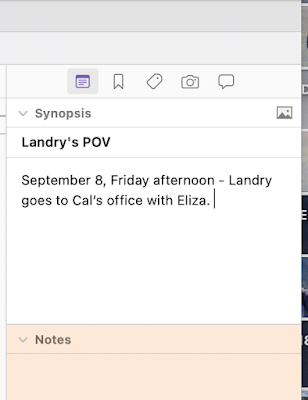
I use Scrivener for this by using the Synopsis feature. I try to remember to update this as I write, but if I forget, I always update it during revision. I include the Day/Date/Time of Day/Setting and then a brief description of what happens in the scene. To help with this, I also keep a copy of the calendars for the time period of the story in the Inspector. Yes, I could look at my phone, a wall calendar, or the calendar on my computer. But having the calendars available in the same file makes it much easier.
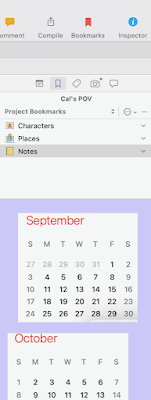
I never, ever skip this step. Just this weekend I discovered that I had a scene that was taking place on both a Friday and Saturday. In the past, I’ve found weeks with two Mondays. I’ve also had 36-hour days. I once had my characters eating breakfast in one paragraph, and just a few paragraphs later, the scene was taking place in the dead of night. I’m all for having breakfast for supper, but that’s not what was happening here.
Using the synopsis and note features in Scrivener makes this much easier for me as I look for any inconsistencies in the timeline.
Inconsistencies with the characters’ names and relationships - For this, I use the notes/bookmark feature in Scrivener. I keep a running list of my characters’ names. Sometimes I throw in a few details. The point of this list is to keep me from naming someone Darryl in Chapter 3 and then Derrick in Chapter 8. And yes, that happened in my current project, but I caught it thanks to my list!
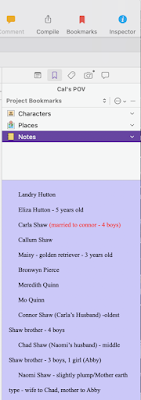
General revision work - I do all the things one does when cleaning up a manuscript. Scrivener’s “find” function works in a similar way to Word’s and I use it to search for overused/weasel words, words that should be contractions, and double words (like “the the” or “and and” - it happens more than you might think).
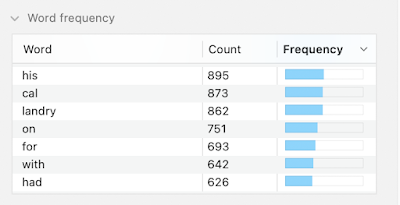
Then I take a look at word frequency. This is not a scientific process of course. But I use this to look for overused words. In this case, I’m not talking about weasel words like just, really, or actually. I’m talking about words that are used in description. So words like “eyebrows” or “narrowed” are good to look for. I might look to see how often my characters “blew out a breath” or “ran their hands through their hair” - we all have some pet descriptions that are fine when used sparingly but are easy to overuse.
I also look for name frequency. I write romantic suspense, and I want my heroine and hero to have fairly equal page time. I can look to see how often I used their names. In this case, my hero’s name is Cal and the heroine’s name is Landry. It was pretty close to 50/50, so I’m happy with that.
There’s more of course, but this post is already way too long and in need of its own revision process! If you use Scrivener and have a favorite tip or trick, please share it with us in the comments!
Grace and peace,Lynn
TWEETABLETips for Using Scrivener on the Second Draft of Your Manuscript from @LynnHBlackburn on @EdieMelson (Click to Tweet)
 Lynn H. Blackburn loves writing romantic suspense because her childhood fantasy was to become a spy, but her grown-up reality is that she's a huge chicken and would have been caught on her first mission. She prefers to live vicariously through her characters and loves putting them into all kinds of terrifying situations while she's sitting at home safe and sound in her pajamas!
Lynn H. Blackburn loves writing romantic suspense because her childhood fantasy was to become a spy, but her grown-up reality is that she's a huge chicken and would have been caught on her first mission. She prefers to live vicariously through her characters and loves putting them into all kinds of terrifying situations while she's sitting at home safe and sound in her pajamas!
Unknown Threat, the first book in her Defend and Protect series, was a 2021 Christy Award finalist and her previous titles have won the Carol Award, the Selah Award, and the Faith, Hope, and Love Reader’s Choice Award. Malicious Intent, the second book in the series, released March 2022.
She is a frequent conference speaker and has taught writers all over the country. Lynn lives in South Carolina with her true love and their three children. You can follow her real life happily ever after by signing up for her newsletter at LYNNHBLACKBURN.COM and @LynnHBlackburn on BOOKBUB, FACEBOOK, TWITTER, PINTEREST, and INSTAGRAM.
As a heavy Scrivener user, I’m frequently asked questions about how I handle multiple drafts and revisions in Scrivener.
If you aren’t familiar with Scrivener, it’s my favorite writing tool. It’s the way I organize everything—my writing, newsletters, social media, blog posts like this one—everything!
If you’re a Scrivener user, hopefully you’ll read something that will give you some ideas for ways you can better utilize the program. And if you don’t use Scrivener, maybe this will encourage you to consider trying it.
Scrivener is NOT for everyone. But for some people it’s a game changer.
First up—let’s cover when I don’t use Scrivener.
As much as I love Scrivener, the industry standard is Word. Revisions are tracked using track changes, and my editors want to see all those changes. So, 99% of the time, once the manuscript goes to my editors, from that point on I do my revisions in Word.
So, when DO I use Scrivener during the revision process?
This is going to come with my usual caveat—YOUR MILEAGE MAY VARY. My revision process is intricately bound with my writing process.
Your process won’t match mine exactly. So take from this what you will.
Also note that I’m an intuitive writer. I don’t outline. I generally write in consecutive order and by the time I get to the end of the story, I’ve already tweaked the beginning multiple times as I’ve gone along. By the time I reach the end, the beginning of the story is technically on its third, fourth, (hundredth?) draft.
When I get to the end, after I cry a little from the sheer relief of having survived the process (#kiddingnotkidding), I save my working Scrivener file, and then I rename it either as “second draft” or with the current date.
This means my first draft is saved “as is” and protected. So if I have one of those moments where I suddenly decide that I’ve made a horrible mistake in the revision process, I can always go back and find the original version. For what it’s worth, I would recommend doing this no matter what program you’re using. Get a copy of the first draft somewhere, save it, and then don’t touch it.
After that’s done, I open my second draft file and start on page 1.
At this point, I’m looking for the following:
Inconsistencies in timeline— are the days/dates/time of year/time of day/people in the scene/location of the scene correct.

I use Scrivener for this by using the Synopsis feature. I try to remember to update this as I write, but if I forget, I always update it during revision. I include the Day/Date/Time of Day/Setting and then a brief description of what happens in the scene. To help with this, I also keep a copy of the calendars for the time period of the story in the Inspector. Yes, I could look at my phone, a wall calendar, or the calendar on my computer. But having the calendars available in the same file makes it much easier.

I never, ever skip this step. Just this weekend I discovered that I had a scene that was taking place on both a Friday and Saturday. In the past, I’ve found weeks with two Mondays. I’ve also had 36-hour days. I once had my characters eating breakfast in one paragraph, and just a few paragraphs later, the scene was taking place in the dead of night. I’m all for having breakfast for supper, but that’s not what was happening here.
Using the synopsis and note features in Scrivener makes this much easier for me as I look for any inconsistencies in the timeline.
Inconsistencies with the characters’ names and relationships - For this, I use the notes/bookmark feature in Scrivener. I keep a running list of my characters’ names. Sometimes I throw in a few details. The point of this list is to keep me from naming someone Darryl in Chapter 3 and then Derrick in Chapter 8. And yes, that happened in my current project, but I caught it thanks to my list!

General revision work - I do all the things one does when cleaning up a manuscript. Scrivener’s “find” function works in a similar way to Word’s and I use it to search for overused/weasel words, words that should be contractions, and double words (like “the the” or “and and” - it happens more than you might think).

Then I take a look at word frequency. This is not a scientific process of course. But I use this to look for overused words. In this case, I’m not talking about weasel words like just, really, or actually. I’m talking about words that are used in description. So words like “eyebrows” or “narrowed” are good to look for. I might look to see how often my characters “blew out a breath” or “ran their hands through their hair” - we all have some pet descriptions that are fine when used sparingly but are easy to overuse.
I also look for name frequency. I write romantic suspense, and I want my heroine and hero to have fairly equal page time. I can look to see how often I used their names. In this case, my hero’s name is Cal and the heroine’s name is Landry. It was pretty close to 50/50, so I’m happy with that.
There’s more of course, but this post is already way too long and in need of its own revision process! If you use Scrivener and have a favorite tip or trick, please share it with us in the comments!
Grace and peace,Lynn
TWEETABLETips for Using Scrivener on the Second Draft of Your Manuscript from @LynnHBlackburn on @EdieMelson (Click to Tweet)
 Lynn H. Blackburn loves writing romantic suspense because her childhood fantasy was to become a spy, but her grown-up reality is that she's a huge chicken and would have been caught on her first mission. She prefers to live vicariously through her characters and loves putting them into all kinds of terrifying situations while she's sitting at home safe and sound in her pajamas!
Lynn H. Blackburn loves writing romantic suspense because her childhood fantasy was to become a spy, but her grown-up reality is that she's a huge chicken and would have been caught on her first mission. She prefers to live vicariously through her characters and loves putting them into all kinds of terrifying situations while she's sitting at home safe and sound in her pajamas! Unknown Threat, the first book in her Defend and Protect series, was a 2021 Christy Award finalist and her previous titles have won the Carol Award, the Selah Award, and the Faith, Hope, and Love Reader’s Choice Award. Malicious Intent, the second book in the series, released March 2022.
She is a frequent conference speaker and has taught writers all over the country. Lynn lives in South Carolina with her true love and their three children. You can follow her real life happily ever after by signing up for her newsletter at LYNNHBLACKBURN.COM and @LynnHBlackburn on BOOKBUB, FACEBOOK, TWITTER, PINTEREST, and INSTAGRAM.
Published on March 01, 2023 22:00



